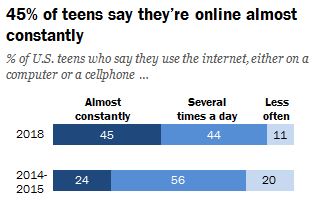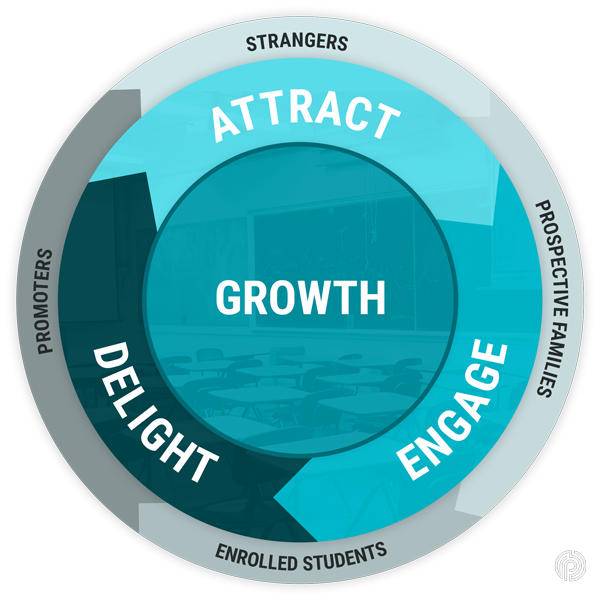Written By:
Will Purcell
Reaching prospective students can be one of the most challenging aspects of enrollment marketing for private and independent schools.
Increased competition, smaller budgets, and competing priorities (recruiting new families while keeping current families happy) can make the process overwhelming for enrollment marketers and admissions teams.
Unfortunately, traditional methods of outreach simply don’t have the same impact as they once did. In order to be effective, schools need to shift their marketing efforts to this new reality.
The rise of Google, social media, and online reviews has facilitated this shift in the power dynamic and given prospective families more control in the selection process overall.
That’s why one of the most influential marketing concepts your school can utilize is the inbound marketing methodology.
Below are a few factors highlighting the decline in independent school enrollment, followed by the current landscape of school marketing as a whole, and finally, how and why inbound marketing is so influential when it comes to increasing overall outreach and enrollment.
School Selection Is Increasingly Informed by Online Research
Filling seats at your school has likely gotten harder over the past few decades, for a number of reasons. Rising costs and increased competition are, of course, important factors. So too, as mentioned above, is this shift in power that has put families in control.
Old marketing and outreach methods simply aren’t as effective as they once were. Print mailers and newspaper ads go largely ignored, while TV and radio ads are tuned out due to DVR and streaming audio services.
Free Toolkit – Create Student Personas For Your School

What makes matters worse is that it is very hard, if not impossible, to measure the effectiveness of these more traditional methods in order to prove an ROI. Why would you spend your limited budget on something that you have no idea whether or not it is working?
Meanwhile, attention has shifted online. 95 percent of teens have access to a smartphone, and 45 percent say they are online ‘almost constantly.’ And online usage is not limited to teens either: 75 percent of internet-using parents use Facebook, which is vastly higher compared to Pinterest (28 percent), Instagram (25 percent), and Twitter (23 percent). Therefore, parents and students alike are now enabled to get the information they need with the click of a button.

There’s no longer a need to call your admission office or even submit an inquiry form to get your tuition rates when a quick Google search provides this information. Parents can find reviews and just about anything they might want to learn about your school and your school community with a search online or by posting a question in a local Facebook group. Whether we like it or not, the parent’s journey towards selecting a school for their child, and the factors that influence it, is now largely online.
Therefore, schools should ask themselves:
- Do we understand what that journey looks like?
- What do parents find along the way? Am I guiding that journey, or is my competition?
- How can we facilitate that journey in a way that puts the family’s needs, challenges and motivations at the center?
What is Inbound Marketing?
Inbound marketing is a marketing methodology that attracts customers by creating valuable content and experiences tailored to them. Essentially, inbound marketing forms connections with consumers based on what they’re looking for and solves their problems through less intrusive methods.
The inbound methodology aids in the buyer’s journey—the process buyers go through to become aware of, consider and evaluate, and decide to purchase a new product or service. For schools, we often use the word term “student’s journey” to refer to the process by which a student becomes aware of, considers and evaluates, and ultimately decides to enroll in a school.
The foundations of the inbound methodology focus on keeping a customer through assistance and support in a way that attracts, engages, and delights. This ‘flywheel’ method helps businesses grow faster and better through a customer-centric approach. The center of the flywheel methodology is ultimately growth, however, it also fuels the efforts of a sales funnel through a symbiotic relationship as well.
Then, through ideation and creation, inbound marketing helps test and optimize performances and techniques meant to aid in your customer’s problems where ultimately, the process will be refined to gain a clearer view of the customers’ needs and motivations.
Inbound is constantly growing and ‘always on’. Simply put, it takes a customer-centric approach that defines the strategy, builds the engine, and executes a campaign by gaining constant feedback to refine and improve upon the buyer’s journey.
Given the influence of inbound marketing in the world of business, how does it benefit schools and education?
Benefits of Inbound for a School
In today’s world, students and parents are more in control when it comes to researching information about their preferred academic institution. Google, Facebook, and Youtube are just a few resources where prospects are conducting their research. Moreover, recent data shows that 88 percent of consumers pre-research their buys before making a purchase.
Inbound marketing helps you, as a school marketer or communications director, answer the questions prospective students are asking online. These results are not only beneficial to fostering a valuable relationship with the consumer, but they also provide quantifiable results that measure your overall marketing success.
Each stage of the inbound methodology comes with its own unique tools that help cultivate meaningful relationships with your prospective students and their families.

The best way of tailoring your school’s marketing efforts to your student’s journey is to create an accurate student persona, which is a semi-fictional representation of who your ideal student (or family) is and what motivates them. (If you’ve never created a student persona before, this interview guide can help.)
After the attract stage comes the ‘engage’ stage where personalization begins for your prospect. Online offers, calls-to-action, and form submissions are just a few methods to increase interaction during this stage. These efforts include email marketing and lead intelligence where the prospective student is given incentive to engage more with your school online.
For example, if a prospective student has a specific question that’s answered in a blog post, a call-to-action could lead that prospect to submit a form highlighting an upcoming school event. This seamless transition from the attract stage to engage stage establishes trust and value with your prospect, which in turn, gives incentive for that student or parent to learn more about your school.
The final stage in the inbound methodology is the ‘delight’ stage. Marketing tools in this stage include surveys, social monitoring, and social communities. At this point in the buyer’s journey, you’ve established trust with a prospective student by providing a solution to a problem. From there, you’ve personalized the prospect’s buyer’s journey through targeted social content and now, you can create memorable content that allows your prospect to evangelize your services and ultimately, keep the flywheel spinning.
Overall, inbound marketing is about focusing on a customer-centered, or in this case, a student-centered approach. Answering the questions prospects are asking online in a nonintrusive, helpful way cultivates a trusting relationship that strengthens your brand through valuable content and information. Knowing this, it’s no secret that inbound is helping rewrite the marketing playbook as a whole.
Inbound is Changing the School Marketing Playbook
When it comes to marketing a school, the playbook has changed and in most cases, is still being defined. The concept of an inbound marketing flywheel requires constant content and feedback to keep spinning. As a result, school marketers must stay up to date with the latest trends and services to effectively meet the needs of a prospect through their buyer’s journey.
Afterall, inbound marketing is about creating content that attracts viewers to your website, rather than intrusively reaching out to prospects yourself. To appropriately apply this strategy to your marketing efforts, you must be adaptive and open to constant innovation.
From a technology standpoint, marketing has changed more in the past decade than ever before. And moving forward, technology will only continue to emphasize growth in marketing overall.
For instance, how will automation impact school marketing efforts? What about artificial intelligence? How will advances in A.I. change the marketing landscape?
These are legitimate questions that marketers, regardless of industry, must ask. With these changes, however, comes a core belief that the marketing playbook is still being written and defined.
That’s one of the many reasons inbound is so valuable to your school. By getting in the minds of the prospects and visitors you’re trying to attract to your website and school, inbound marketing will help you grow and target your marketing efforts so that you ultimately grow your prospective student base, retain your current students, and help prospective parents by giving them content they want and need when making a decision.
Starting Your Inbound Journey: Finding A Guide
Inbound marketing is a unique and innovative strategy that fuels the buyer’s journey with valuable content to ultimately cultivate trust between a business and their customers.
For a school, there are several elements of an inbound campaign that must be utilized to aid in overall success. In the attract stage, what content should you write and produce to prospects? Is some content more effective than others?
What about the engage stage? How should a landing page look for an Open House form submission as opposed to an Application Page?
Then there’s the delight stage, what should a survey or social community include? How do you quantify these results and adapt your strategy based upon those results?
Obviously, these loaded questions include several factors both from a demographics and geographical standpoint. A school in New England may have different needs and challenges than a school in the southwest or southeast. Some concepts may be universal, but the majority of content should target a specific prospect based upon their own unique buyer’s journey.
Tackling all of these factors can be a daunting task for school marketing and communications professionals, but fortunately, help is available. Several services provide assistance with inbound efforts—whether it’s determining what content works best, creating landing pages, or finding solutions to technical SEO challenges.
These specialized agencies can aid in your inbound marketing efforts, regardless of your familiarity with inbound, or with marketing in general. Even if you are already using inbound marketing strategies, these services can help enhance your efforts to ultimately grow enrollment and outreach.
Today’s marketers are constantly tasked with adapting and growing their efforts to meet the ever-increasing technological demands. These technological advances have created a new type of consumer—one who is well versed in a product or service before they ever step foot on the property.
To match this new type of prospect, marketers must think differently and employ services to help them stay afloat in the ever-evolving industry. By utilizing inbound marketing efforts, marketing and communications directors at schools can create new and trusting relationships with prospective students and families in a non intrusive, helpful way.







